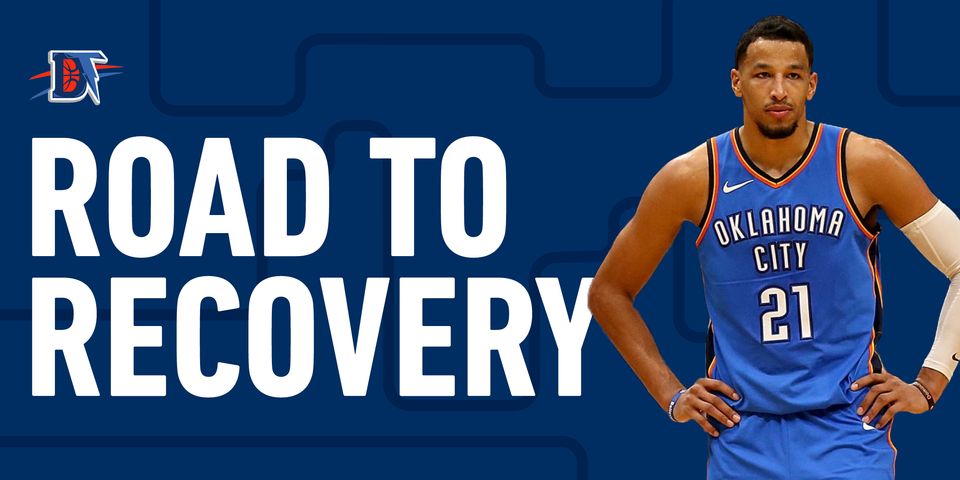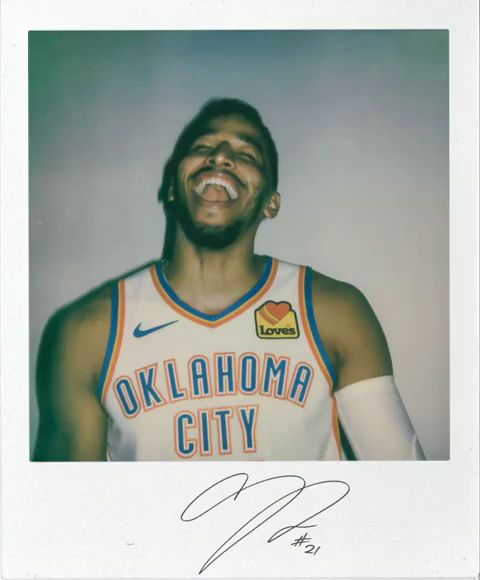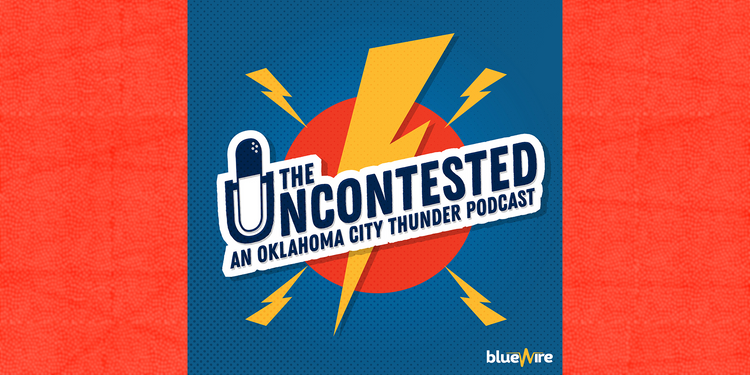The Road to Recovery: Andre Roberson

On January 27th, 2018, Andre Roberson ruptured his patellar tendon while going up for a lob from Russell Westbrook. It has been over 660 days since Roberson’s injury and in that time, very little information has been released about Roberson’s recovery and estimated return.

When asked before the Thunder’s game against the Sixers on November 15th whether Roberson would return this season, Coach Billy Donovan said:
I hope so. For him. But like I said last game, I just don’t have a timetable to be able to say when that would be. We’re hopeful. He’s a lot better off today than was last year [at this time], I’ll say that. But where that leads and how far away from playing is he, it’s just too hard for me to say… I don’t deal with it every day just because when there’s things that they need to update me on, they update me. I try to encourage Andre and keep his spirits up because he has worked hard and he’s doing what he can to get back on the court. via Norman Transcript
Coach Donovan gave another update to the media on November 21st, but basically echoed his previous sentiments (that Roberson is anxious to get back but is “just not ready” yet):
I know for him it’s been very frustrating because he’s so anxious to get out there and play. But I also think, too, is he really wants to feel like he’s capable of going out there. You’ve been out for almost going on two years now, you want to go out there and make sure you’re ready to play, you’re ready to be able to provide quality minutes, and you’re in a good place mentally and physically to be able to do that. I think he’s gaining confidence, he’s gaining trust. I think when we work him out, it’s an opportuity to help him get a little bit stronger. But I think for him, he’s really not quite all the way there from a comfort standpoint. I think that’s what he’s trying to work towards.via The Athletic
Many Thunder fans feel they are entitled to more information about Roberson’s recovery, but frankly, they are not. The specific details about a player’s health are withheld from fans and the media for several reasons, including to protect the player. For example, if the details of every one of Roberson’s minor setbacks are released, they have the potential to negatively impact Roberson’s trade value and future salary. Furthermore, the consequences of Roberson returning too soon (see: Kevin Durant) far exceed the advantages of having Roberson back on the court. This isn’t Game 7 of the Finals where Roberson is OKC’s best player. It’s the first month of a regular season in which the Thunder are not championship contenders or even playoff hopefuls. Why rush Roberson’s return?
That being said, Roberson’s recovery timeline is not even atypical compared to past patellar tendon ruptures in the NBA. Had Roberson not suffered the patellar avulsion fracture in addition to the patellar tendon rupture, he was projected to return in December 2018– approximately one year after the injury. Compared to other players with patellar tendon ruptures, the average return-to-play time is about one year. Granted, the sample size is small because patellar tendon ruptures are rare in the NBA and typically occur in older players. In the past 19 years, only these four NBA players have suffered the injury. (Note: The term “patellar tendon tear” is used to refer to partial tears of the patellar tendon whereas “rupture” refers to a complete tear.)
1. Antonio McDyess (2001)
McDyess’s case is the most similar to Roberson’s in that both players were about the same age at the time of injury and experienced similar setbacks. At 27 years old, McDyess ruptured his patellar tendon and underwent surgery to repair the tendon at the start of the 2001-2002 season. Later that same season, he attempted a return but ended up re-aggravating the injury and missed the rest of the season. McDyess was cleared for the 2002-2003 season but fractured his patella while coming down from a dunk in an exhibition game exactly one year after his initial patellar tendon rupture. McDyess finally returned on December 1, 2003 (780 days after his initial injury).
Despite his multiple setbacks, McDyess was able to reinvent his game. During the 2005-2006 season, he shot 51.3% from the field (13th in the NBA) and helped the Detroit Pistons reach the 2006 NBA Finals as their sixth man. McDyess retired from the NBA in 2011 at age 36 (10 years after his initial patellar tendon rupture).
2. Damon Stoudemire (2005)
Stoudemire ruptured his patellar tendon in December 2005 at age 32 and returned-to-play in November 2006, roughly a year later. He did not suffer any significant setbacks in his recovery and was able to play 62 games (starting 51) during the 2006-2007 season. At the time of Stoudemire’s injury, he was already nearing the end of his thirteen-year career. He was ultimately replaced by Mike Conley, picked fourth-overall in the 2007 draft, as the starting point guard for the Memphis Grizzlies. Stoudemire retired from the NBA in 2008 at age 34, three years after his injury.
3. Caron Butler (2011)
On January 4, 2011, Butler ruptured his patellar tendon at age 31 and returned in December 2011, approximately a year later. Like Stoudemire, Butler did not experience any significant setbacks in his recovery. He played in 63 of the 66 regular-season games during the 2011-2012 lockout season and averaged 8.6 points per game for the Los Angeles Clippers in the 2012 NBA Playoffs. He went on to average 9.7 points per game as a key member of the Thunder bench in 2013-2014. During the 2014-2015 season, Butler played in 78 games and started 21 of those games for the Detroit Pistons. He retired from the NBA in 2016 at age 35, five years after his injury.
4. Jeremy Lin (2017)
Lin ruptured his patellar tendon on opening night of the 2017-2018 season at age 29. Similar to Stoudemire and Butler, he did not experience any significant setbacks in his recovery and returned at the start of the 2018-2019 season almost exactly a year later. While recovering from injury, Lin was traded from the Brooklyn Nets to the Atlanta Hawks. He averaged 10.7 points in 19.7 minutes per game (51 games played) for the Hawks before they waived him in February 2019. Lin signed with the Toronto Raptors and after the 2019-2020 season, he became a free agent. He currently plays for the Beijing Ducks.
Six notable players (Glen Rice, Alonzo Mourning, Kelenna Azubuike, Carmelo Anthony, David Lee, and Dante Exum) experienced partial patellar tendon tears between 2000-2019. A patellar tendon tear is a distinct injury from a rupture because the repair and recovery processes are quite different. A small tear may not even require surgery, as was the case with David Lee. The immediate post-injury retirements of Glen Rice and David Lee could be used to argue that patellar tendon injuries are often career-ending. However, Rice’s injury and retirement occurred in his 15th NBA season (age 37) and Lee’s injury and retirement occurred in his 12th NBA season (age 34). The only example of early retirement from professional basketball following a patellar tendon tear or rupture in the past 20 years is Kelenna Azubuike.
Azubuike was an undrafted player who got called up from the D-League by the Golden State Warriors in 2009. After his injury, he was traded by the Warriors to the New York Knicks, who immediately waived him. Two years later, he signed with the Dallas Mavericks on a two-way contract. He was traded again in the summer of 2012 to the Cleveland Cavaliers, who immediately waived him. Tearing his patellar tendon probably didn’t help Azubuike’s NBA dreams, but it’s not like he was a top draft prospect. I don’t think that if Azubuike had not torn his patellar tendon, he would be on an NBA roster today.
A career arc similar to Anotonio McDyess is probably the best-case scenario for Roberson, while Azubuike’s career is the worst-case scenario. In all likelihood, Roberson ends up somewhere in between meaning that he does return at some point this season. Furthermore, if history is any indication, Roberson’s career is not over. If he’s able to adapt his game to account for decreased lateral mobility, Roberson could still have a valuable defensive role on an NBA team. Unfortunately for Roberson, the long-term goals of the Oklahoma City Thunder shifted dramatically while he has been recovering and he might not have a spot on the Thunder for long, even if he does reinvent his game and improve his shooting.
At the time when Roberson tore his patellar tendon, the Thunder were one of the best defensive teams in the league (due in large part to Roberson) and had enough superstar talent on the team to account for Roberson’s offensive liabilities. Not only are the Thunder lacking superstar talent at the moment, but the team is also focused on developing young players like Terrance Ferguson, Hamidou Diallo, and Darius Bazley (who all happen to play on the wing, like Roberson) even if they’re not as defensively-skilled as the best version of Roberson was.

Roberson’s road to recovery has been one filled with many obstacles and several unknowns, but I strongly believe that his road has not reached its end. I do think that Roberson returns this season, but it might not be on the timeline that Thunder fans are expecting. When he does, he might not be a member of the Thunder for long, but that will be because the Thunder have outgrown him and not because Roberson doesn’t have NBA value. I, for one, am rooting for Roberson’s return no matter how long it takes.
Olivia Panchal graduated from the University of Southern California with a degree in Human Biology with an emphasis in Sports Performance. Her research on ACL injuries in both amateur and professional athletes has been published by the American Physical Therapy Association and the American College of Sports Medicine. She also holds a master’s degree in Biomedical Science.

